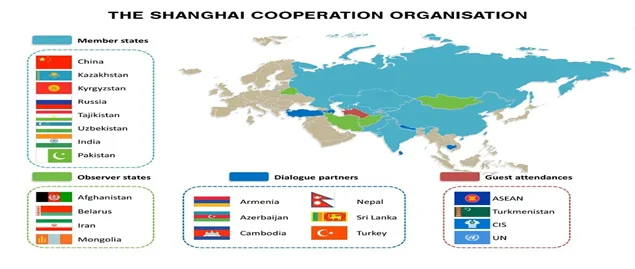International Relations
Context: Shanghai Cooperation Organisation (SCO) meeting (September 2022) in Samarkand, Uzbekistan, was a test case for governments on how to deal with current conflicts and attempt new guidelines for the future.

About Shanghai Cooperation Organization (SCO):
- SCO is an intergovernmental international organisation that exists indefinitely. It was founded in 2001. The SCO Charter was signed in 2002 and took effect in 2003.
- SCO is a Eurasian political, economic, and security partnership. It is the world’s largest regional organisation in terms of geographic breadth and population, spanning around 60% of Eurasia, 40% of the world population, and more than 30% of global GDP.
Structure of the SCO:
- Heads of State Council – The top SCO body that decides on internal SCO operations, interactions with other states and international organisations, and international concerns.
- Heads of Government Council – Approves the budget and evaluates and decides on topics pertaining to SCO’s economic domains of engagement.
- Council of Foreign Ministers – Considers problems concerning day-to-day operations.
- Regional Anti-Terrorist Structure (RATS) – An organisation formed to combat terrorism, separatism, and extremism.
New version of non-alignment:
- India’s presence at the meeting of the Council of Heads of State of the SCO was significant, reflecting a desire to be a part of both blocs, without antagonising either.
- On the other hand, in his formal opening remarks at the summit, Mr. Modi thanked both Russia and Ukraine for the evacuation of Indian students from Ukraine, highlighting India’s posture of equidistance between the two countries.
- The philosophical underpinning for this seems to be that ‘Nonalignment of the past’ had not succeeded, and a way had to be found for “multiple engagements of the future”.
- Recently the United States and other western allies had complimented India for its participation in the Quad (Australia, Japan, India, and the U.S.).
- Whether India can make out a case for ‘mixing utopia with reality’ under the label of ‘multi alignment’ is yet to be seen, but it does provide grist to an idea being floated that this provides leeway for India to play a much bigger role in ‘managing conflict’.
- It would be interesting to see whether this SCO summit will pave the way for India to exploit other situations created by political contradictions and use them to its advantage.
- A test case is India’s relations with Iran which have been on the backburner for some time, following a U.S. threat to impose sanctions on India if it continued to trade with Iran.
- Refashioning India’s foreign policy has become vital at a time when India is facing a confluence of old and new situations and threats, which often intersect.
Ties with China:
- India’s foreign policy should be creative enough to leave an opening for an improvement in India-China relations over the longer term.
- Again, the intensity of the current conflict between India and China should not lead India’s strategic establishment to overlook the fact that the primary conflict between India and China is ‘civilizational’, and not for territory.
- India’s foreign policy mandarins must look for opportunities for the betterment of relations at an opportune time, which could well arise when China’s economy begins to stall and India’s economy rises, moderating China’s current aggressive behaviour.
Nuclear dimension
- An issue that has remained on the backburner for years may now need consideration in the context of the Ukraine-Russia conflict, viz., the nuclear dimension.
- We have a ‘No First Use Doctrine’, and while nuclear relationships involving India, China and Pakistan have remained remarkably subdued over many years, India’s strategic and foreign policy establishment cannot afford to overlook the nuclear aspect, given that the country is wedged between two active, and hostile, nuclear powers — China and Pakistan.
- We cannot ignore the growing sophistication of Chinese nuclear forces, and to a lesser extent that of Pakistan, which has the effect of putting India at a disadvantage with both predictable and unpredictable consequences.
- India’s new foreign policy imperatives cannot again afford to ignore this aspect, even though at present India is the only one among the three that does not see nuclear weapons as intended for use in the event of a war.
Conclusion:
Hence, navigating the coming decade necessitates giving up many of the existing policy constructs, providing for a wider outreach, and ensuring that our policy is not merely in step with current needs but is always a step ahead.
Source: The Hindu














